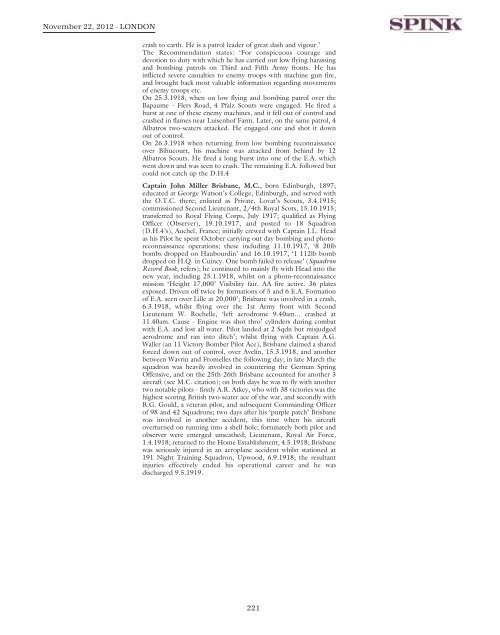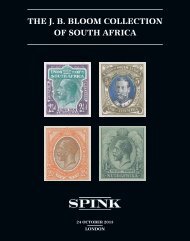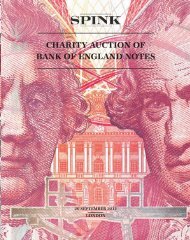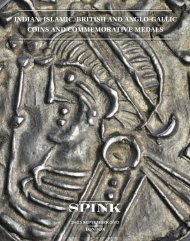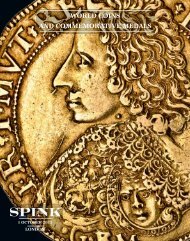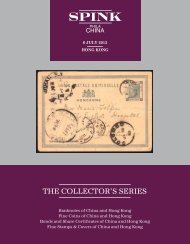orders, decorations, campaign medals and militaria - Spink
orders, decorations, campaign medals and militaria - Spink
orders, decorations, campaign medals and militaria - Spink
Create successful ePaper yourself
Turn your PDF publications into a flip-book with our unique Google optimized e-Paper software.
November 22, 2012 - LoNdoN<br />
crash to earth. He is a patrol leader of great dash <strong>and</strong> vigour.’<br />
The Recommendation states: ‘For conspicuous courage <strong>and</strong><br />
devotion to duty with which he has carried out low flying harassing<br />
<strong>and</strong> bombing patrols on Third <strong>and</strong> Fifth Army fronts. He has<br />
inflicted severe casualties to enemy troops with machine gun fire,<br />
<strong>and</strong> brought back most valuable information regarding movements<br />
of enemy troops etc.<br />
On 25.3.1918, when on low flying <strong>and</strong> bombing patrol over the<br />
Bapaume - Flers Road, 4 Pfalz Scouts were engaged. He fired a<br />
burst at one of these enemy machines, <strong>and</strong> it fell out of control <strong>and</strong><br />
crashed in flames near Luisenhof Farm. Later, on the same patrol, 4<br />
Albatros two-seaters attacked. He engaged one <strong>and</strong> shot it down<br />
out of control.<br />
On 26.3.1918 when returning from low bombing reconnaissance<br />
over Bihucourt, his machine was attacked from behind by 12<br />
Albatros Scouts. He fired a long burst into one of the E.A. which<br />
went down <strong>and</strong> was seen to crash. The remaining E.A. followed but<br />
could not catch up the D.H.4<br />
Captain John Miller Brisbane, M.C., born Edinburgh, 1897;<br />
educated at George Watson’s College, Edinburgh, <strong>and</strong> served with<br />
the O.T.C. there; enlisted as Private, Lovat’s Scouts, 3.4.1915;<br />
commissioned Second Lieutenant, 2/4th Royal Scots, 15.10.1915;<br />
transferred to Royal Flying Corps, July 1917; qualified as Flying<br />
Officer (Observer), 19.10.1917, <strong>and</strong> posted to 18 Squadron<br />
(D.H.4’s), Auchel, France; initially crewed with Captain J.L. Head<br />
as his Pilot he spent October carrying out day bombing <strong>and</strong> photoreconnaissance<br />
operations; these including 11.10.1917, ‘8 20lb<br />
bombs dropped on Haubourdin’ <strong>and</strong> 16.10.1917, ‘1 112lb bomb<br />
dropped on H.Q. in Cuincy. One bomb failed to release’ (Squadron<br />
Record Book, refers); he continued to mainly fly with Head into the<br />
new year, including 25.1.1918, whilst on a photo-reconnaissance<br />
mission ‘Height 17,000’ Visibility fair. AA fire active. 36 plates<br />
exposed. Driven off twice by formations of 5 <strong>and</strong> 6 E.A. Formation<br />
of E.A. seen over Lille at 20,000’; Brisbane was involved in a crash,<br />
6.3.1918, whilst flying over the 1st Army front with Second<br />
Lieutenant W. Rochelle, ‘left aerodrome 9.40am... crashed at<br />
11.40am. Cause - Engine was shot thro’ cylinders during combat<br />
with E.A. <strong>and</strong> lost all water. Pilot l<strong>and</strong>ed at 2 Sqdn but misjudged<br />
aerodrome <strong>and</strong> ran into ditch’; whilst flying with Captain A.G.<br />
Waller (an 11 Victory Bomber Pilot Ace), Brisbane claimed a shared<br />
forced down out of control, over Avelin, 15.3.1918, <strong>and</strong> another<br />
between Wavrin <strong>and</strong> Fromelles the following day; in late March the<br />
squadron was heavily involved in countering the German Spring<br />
Offensive, <strong>and</strong> on the 25th-26th Brisbane accounted for another 3<br />
aircraft (see M.C. citation); on both days he was to fly with another<br />
two notable pilots - firstly A.R. Atkey, who with 38 victories was the<br />
highest scoring British two-seater ace of the war, <strong>and</strong> secondly with<br />
R.G. Gould, a veteran pilot, <strong>and</strong> subsequent Comm<strong>and</strong>ing Officer<br />
of 98 <strong>and</strong> 42 Squadrons; two days after his ‘purple patch’ Brisbane<br />
was involved in another accident, this time when his aircraft<br />
overturned on running into a shell hole; fortunately both pilot <strong>and</strong><br />
observer were emerged unscathed; Lieutenant, Royal Air Force,<br />
1.4.1918; returned to the Home Establishment, 4.5.1918; Brisbane<br />
was seriously injured in an aeroplane accident whilst stationed at<br />
191 Night Training Squadron, Upwood, 6.9.1918; the resultant<br />
injuries effectively ended his operational career <strong>and</strong> he was<br />
discharged 9.5.1919.<br />
221


